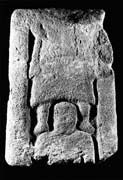Select a site alphabetically from the choices shown in the box below. Alternatively, browse sculptural examples using the Forward/Back buttons.
Chapters for this volume, along with copies of original in-text images, are available here.
Object type: Part of cross-shaft
Measurements: H. 53.2 cm (21 in); W. 35 > 33 cm (13.75 > 13 in); D. 30.5 > 27.8 cm (12 > 11 in)
Stone type: Very coarse-grained (with quartzite pebbles up to 10 mm), feldspathic, very pale brown (10YR 7/3, with brownish-yellow (10 (10YR 6/6 flecks) grit; Millstone Grit, Namurian, Upper Carboniferous; probably reused Roman ashlar, perhaps from York and, if so, originally from Hetchell Crag (Thorner) or Otley area (see Fig 5).
Plate numbers in printed volume: Fig. 7d-e; 446-449
Corpus volume reference: Vol 3 p. 131-132
(There may be more views or larger images available for this item. Click on the thumbnail image to view.)
A (broad): The flat edge moulding is wide and heavy. Within the panel are the head and shoulders of a human figure. The face is oval. On its shoulders stands a second figure, its head lost. The hem of the upper figure's kirtle dips at each side, forming a shallow arch over the lower figure's head. The feet are splayed. Two sleeved arms hang at the sides. On the chest is an incised rectangle with a central vertical incision.
B (narrow): The flat edge moulding is wide. The panel contains an irregular interlace with bifurcating strands. The strands are double-incised, the central strip being broader than the flanking ones, giving the appearance of double outlining like that of one of the animals on face C. Faint traces of red on the strand and moulding may be pigment.
C (broad): The flat edge moulding is wide, if chipped. Within the panel are remains of a beast-chain, deeply cut. The lower beast survives as a head, long thrown-back neck, spiral fore leg joint and tapered waist. The elliptical eye is incised. The snout has a single upward curl; the lower jaw is tipped downwards. It bites the leg of the upper beast. The beast has a double outline, which extends into a fore leg. Another fore leg is raised, and has a frond-like paw. The extended ear is median-incised and interlaces with another fetter which crosses the neck before passing over the waist. The upper animal has a scrolled hind leg joint and its fore leg grows into the interlace. The fetters have angular turnings.
D (narrow): The flat edge moulding is wide. The panel contains a beast-chain; two long-necked fettered animals survive. There are no traces of contouring or median incision of strands. The lower animal throws back its head, its extended ear passing through the fetters across the ankle to join the strands which grow out of the legs. The leg joints have scrolls, especially on the head. The upper beast's hind legs slip downwards and the foot is sub-elliptical. Its fore leg has a scrolled joint. The tail runs parallel to the inclined back. There is a hint of an elongated neck. The interlace has angular loops.
The beast-chains of faces C and D are characteristic of growing Anglo-Scandinavian taste in the region. The long-necked quadruped has its ancestry in Anglian sculptural animal ornament, probably in Mercia (see Chap. 9). The posture, the thick chest, the incipient fettering and the diagonal disposition may be seen in pre Viking-age work at Breedon, Leicestershire (Fig. 7a), and Derby (Lang 1978b, 148–9, fig. 8.3). The substantial proportions of the animals look back to that source, but the dense packing and minor decorative details are to be found in York Anglo-Scandinavian designs. The Folkton shaft provides a link between Nunburnholme 1 and York Minster 2, establishing a smooth transition from Anglian to Viking-age styles (Lang 1978c, 13–15, fig. 2), if such a progression be required at all. The present carving may simply be in a more pure mould from its Anglian model than the ribbon beasts of York Minster.
The human figures are unusual. Their arrangement, without transverse panel divisions, is probably due to the desire for minimal cutting of the stone, a principal governing the beast-chains of the other faces. The upper figure may be a priest with book and maniple. The absence of halo on the other would preclude its being a saint. The split strand of face B is unusual and may be bungling; it is certainly unlike the Manx versions.



